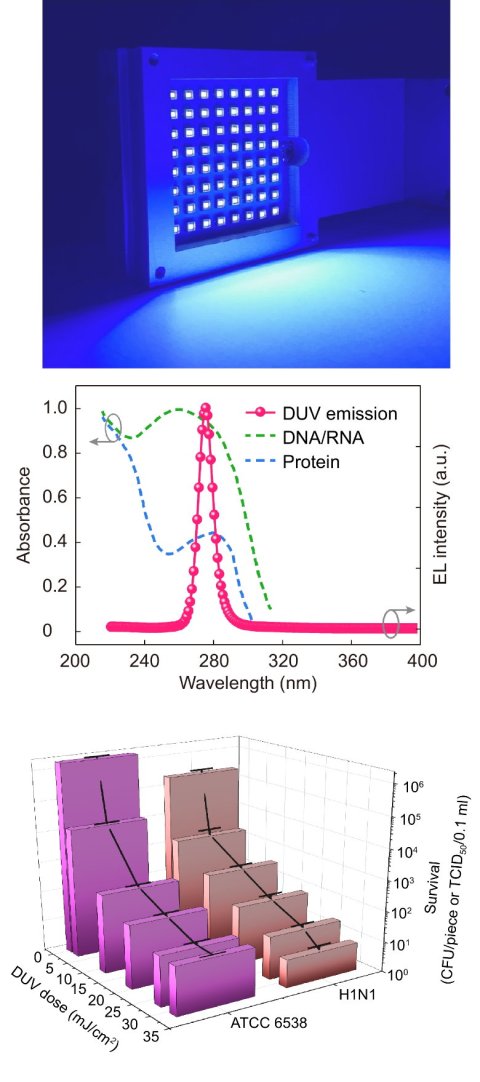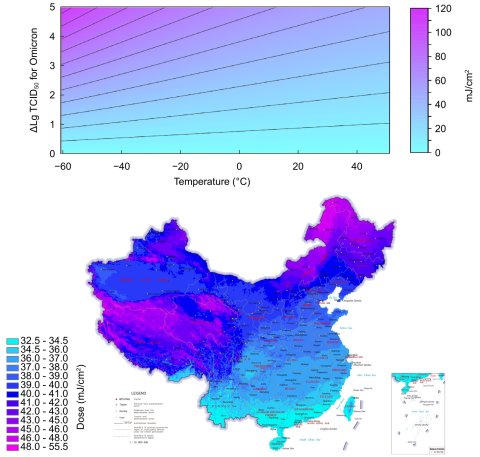News • In the cryogenic environment
Deep-ultraviolet photonics for Sars-CoV-2 disinfection
A new publication discusses deep-ultraviolet (DUV) photonics for the disinfection of Sars-CoV-2 and its variants (Delta and Omicron) in the cryogenic environment.

Image source: OEA; from: Kang et al., Opto-Electronic Advances 2022 (CC BY 4.0)
The research was published in Opto-Electronic Advances.
Deep ultraviolet (DUV) irradiation is a fast and effective way to inhibit the spread of pathogenic microorganisms, because it can directly destroy the genetic materials of microorganisms or prevent the effective replication of genetic material. Since the outbreak of Covid-19 (elicited by Sars-CoV-2), ultraviolet technology has been used for air and surface disinfection. However, the influences of Sars-CoV-2 viral variants (Delta and Omicron) and low temperatures on the DUV virucidal efficacy are still unknown. In particular, the Sars-CoV-2 is able to survive longer in low temperatures, and relevant authorities have repeatedly tested Covid-positive on the surface of goods in cold-chain logistics. Therefore, it would be very important to understand DUV photonics for the disinfection of Sars-CoV-2 and its variants in the cryogenic environment, and thus help the building of the biosafety barrier.
Simultaneously, the traditional ultraviolet light sources (represented by mercury lamps) are going to fade away due to the potential pollution to the environment (the implementation of the Minamata Convention). The DUV solid-state light source has the advantages of narrow-band wavelength, eco-friendly, compact, and high-speed switch etc., and it would represent the future trend of the ultraviolet light source with outstanding scientific and practical value. At the current stage, DUV solid-state light source still needs to steadily improve its irradiation intensity, area, and uniformity to achieve a large-area and high-efficiency disinfection.
The research group from Xiamen University developed a high light output (3.2 W) and uniform planar light source comprised of 275-nm light-emitting diodes (LEDs) based on the germicidal effectiveness curve. This light source could kill the Sars-CoV-2, H1N1, and staphylococcus aureus (≥99.99% at room temperature) within 1 second.

Image source: OEA; from: Kang et al., Opto-Electronic Advances 2022 (CC BY 4.0)
Meanwhile, the research gaps were filled regarding the influences of viral variants (Delta and Omicron) and low temperatures on the DUV virucidal efficacy. The lethal effect of DUV was reduced by the cryogenic environment, for instance, the DUV dose needed to be doubled at -50°C to achieve the same inactivation performance compared to the room temperature for the variant of Omicron. This was mainly elicited by the different thermal energy and the chance of capture in the negative-U large-relaxation model. Besides, the inactivation of Omicron required a significantly higher DUV dose compared to other viral strains, which was theoretically due to its genetic and proteinic characteristics.
Last but not least, this research group investigated the relationship between the DUV dose and the virucidal efficacy of Sars-CoV-2 at different temperatures. The findings in this study would be significant for human society using DUV disinfection in cold conditions (e.g., the food cold chain logistics and the open air in winter), and the relevant DUV disinfection suggestion against Covid-19 was provided.
Source: Compuscript Ltd
30.06.2023











